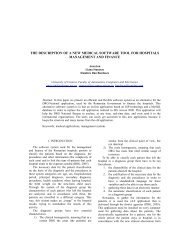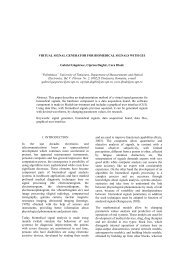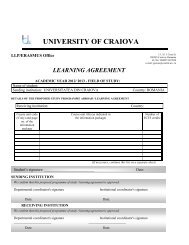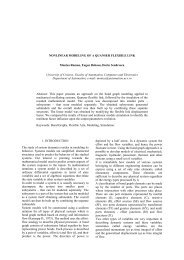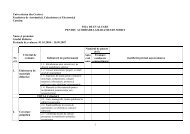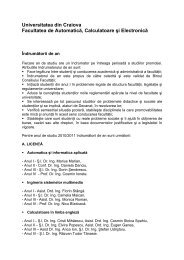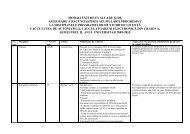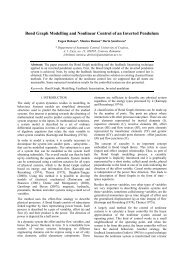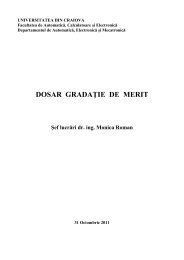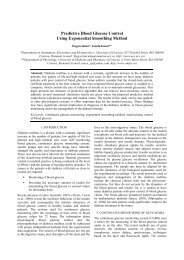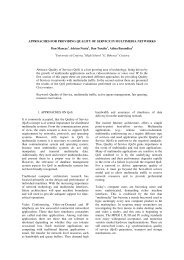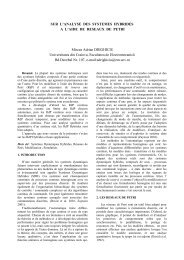Absolute Stability of a longitudinal Blended Wing Body Aircraft ...
Absolute Stability of a longitudinal Blended Wing Body Aircraft ...
Absolute Stability of a longitudinal Blended Wing Body Aircraft ...
Create successful ePaper yourself
Turn your PDF publications into a flip-book with our unique Google optimized e-Paper software.
<strong>Absolute</strong> <strong>Stability</strong> <strong>of</strong> a <strong>longitudinal</strong><br />
<strong>Blended</strong> <strong>Wing</strong> <strong>Body</strong> <strong>Aircraft</strong> Model with<br />
Rate Limiting <strong>of</strong> the Actuator ⋆<br />
Claudia Alice State ∗<br />
∗ Doctoral School <strong>of</strong> Control Engineering and Computers,<br />
University <strong>of</strong> Craiova, A.I.Cuza, 13, Craiova, RO-200585, Romania<br />
(e-mail: cldstate@ yahoo.com).<br />
Abstract: This paper is focused on P(ilot) I(n-the-Loop) O(scillations) <strong>of</strong> Category II<br />
associated to quasi-linear models, which are induced by nonlinearities determined by the<br />
saturation <strong>of</strong> position or rate limited elements. The theoretical model <strong>of</strong> the airplane is a <strong>Blended</strong><br />
<strong>Wing</strong> <strong>Body</strong> (BWB) configuration and the human operator is expressed by the Synchronous Pilot<br />
Model, represented by a simple gain. The absolute stability for the <strong>longitudinal</strong> BWB aircraft<br />
model proposed is investigated using a frequency Popov-type criterion. The mathematical model<br />
presented in this article is a pilot-aircraft coupled system used for describing the <strong>longitudinal</strong><br />
motion <strong>of</strong> the <strong>Blended</strong> <strong>Wing</strong> aircraft and techniques from the frequency domain are applied. The<br />
transfer function obtained from open-loop analysis has a double pole at the origin. Therefore,<br />
the pilot-aircraft system is in the critical case <strong>of</strong> a double zero root and the Popov criterion, in<br />
the case <strong>of</strong> the infinite parameter, is applied in order to investigate the absolute stability for the<br />
<strong>longitudinal</strong> BWB aircraft model in the presence <strong>of</strong> the rate saturation <strong>of</strong> the actuator.<br />
Keywords: <strong>Absolute</strong> stability, Popov criterion, Nonlinear system, <strong>Blended</strong> <strong>Wing</strong> <strong>Body</strong>,<br />
Frequency domain inequality<br />
1. INTRODUCTION<br />
Known to have been the cause for several aircraft incidents<br />
and accidents, the pilot-induced oscillations (PIO)<br />
are dangerous and complicated interactions between the<br />
human pilot and the aircraft dynamics that can lead to<br />
destruction <strong>of</strong> the aircraft, and it <strong>of</strong>ten occurs when the<br />
pilot <strong>of</strong> an aircraft proves to be unable to adapt himself<br />
to a sudden change <strong>of</strong> the vehicle dynamics during a high<br />
demanding flight task.<br />
A PIO event can be considered as a closed-loop instability<br />
caused by dynamic coupling between the pilot and the<br />
aircraft, which is described in the specific literature as<br />
”sustained or uncontrollable oscillations resulting from<br />
efforts <strong>of</strong> the pilot to control the aircraft” (Jeram and<br />
Prasad (2003)) or ”inadvertent, sustained aircraft oscillation<br />
which is the consequence <strong>of</strong> an abnormal joint enterprise<br />
between the aircraft and the pilot” (McRuer (1992)).<br />
According to common references (see, for example, McRuer<br />
et al. (1996)), PIOs can be separated into four categories.<br />
PIO Category I mainly concerns to linear pilot-vehicle<br />
system oscillations. These PIOs result from linear phenomena<br />
such as excessive lags introduced by filters,<br />
actuators, feel system and digital system time delays.<br />
They are the simplest to model and prevent.<br />
PIO Category II is characterised by quasi-linear pilotvehicle<br />
models, but with some nonlinear contribution,<br />
⋆ This work has been partly supported by the Research Project<br />
CNCSIS ID-95<br />
such as rate or position limiting. The closed loop pilotvehicle<br />
system has a nonlinear behavior, mainly characterized<br />
by the saturation <strong>of</strong> position or rate limited<br />
elements.<br />
PIO Category III is enough evasive defined as completely<br />
nonlinear. The closed loop pilot-vehicle system has a<br />
highly non-linear behaviour, with no further peculiar<br />
characteristic. These severe life-threatening PIOs are<br />
caused by nonlinearities and transitions in pilot or<br />
effective airplane dynamics.<br />
PIO Category IV which refers to coupling effects between<br />
pilot inputs and the aircraft structural modes, is<br />
characterised by highly non-linear pilot-vehicle system<br />
oscillations. These PIOs are theoretically considered and<br />
less studied.<br />
This paper deal with the analysis <strong>of</strong> Category II PIOs,<br />
which are mainly characterised by nonlinearities determined<br />
by rate or position saturations <strong>of</strong> control surface actuators.<br />
Caused by dynamic coupling between the human<br />
pilot and the aircraft, these oscillations can occurs with<br />
motions about all or any symmetry axes <strong>of</strong> the aircraft,<br />
and this could lead to instability in the systems.<br />
One <strong>of</strong> the goal <strong>of</strong> this paper is to provide a frequency criterion<br />
to establish whether a given aircraft is free from PIO<br />
<strong>of</strong> Category II. Pilot-in-the-loop analysis <strong>of</strong> the aircraft<br />
dynamics involves adoption <strong>of</strong> mathematical models <strong>of</strong> the<br />
human pilot, which can be a useful tool for predicting<br />
these PIOs. The theoretical model <strong>of</strong> the airplane is a<br />
<strong>Blended</strong> <strong>Wing</strong> <strong>Body</strong> (BWB) tailless configuration which is<br />
claimed to have a superior aerodynamic performance. As<br />
54
Fig. 2. Simplified actuator model with rate limiting<br />
Fig. 1. BWB concept aircraft<br />
a mathematical model <strong>of</strong> the human pilot, Synchronous<br />
Pilot Model is considered, represented by a simple gain.<br />
1.1 BWB concept<br />
Defined as having no definite fuselage and only a single<br />
wing, the <strong>Blended</strong> <strong>Wing</strong> aircraft generate less noise and<br />
<strong>of</strong>fers a greater lift-to-drag ratio than traditional aircraft.<br />
The BWB aircraft model also <strong>of</strong>fers a reduction in the<br />
number <strong>of</strong> parts required relating to reduced manufacturing<br />
costs. Figure 1 ilustrates a representative BWB tailless<br />
aircraft.<br />
An intuitive presentation <strong>of</strong> the BWB concept can be<br />
found in (Chambers (2005)). Also, several researches regarding<br />
this particular configuration are, for example,<br />
(Rahman and Whidborne (2008)) and (Smith and Abbasi<br />
(2004)).<br />
The aerodynamic BWB model used here was obtained taking<br />
into consideration (Castro (2003)) and (Rahman et al.<br />
(2009)). The linear low order BWB aircraft model for the<br />
uncoupled <strong>longitudinal</strong> dynamics was considered taking<br />
into account the case <strong>of</strong> short-period approximation. In<br />
addition, only elevator control δ e was retained.<br />
1.2 Actuator Rate Limiting<br />
For absolute stability analysis, the nonlinear equations<br />
<strong>of</strong> motion describing the aircraft dynamics were obtained<br />
using the rate limiting <strong>of</strong> the actuator, representing the<br />
nonlinear part <strong>of</strong> the <strong>longitudinal</strong> model presented in this<br />
article.<br />
Rate limiting <strong>of</strong> the actuator is one <strong>of</strong> main factors<br />
contributing to Category II PIO. A block diagram <strong>of</strong> a<br />
basic rate-limited actuator model is presented in Figure 2,<br />
where the pilot input command u to the actuator produces<br />
the actual actuator deflection. The output deflection δ is<br />
fed back to the input surface command to produce an<br />
error signal. In the forward path the error signal serves as<br />
the input to the nonlinear saturation block. Actuator rate<br />
limiting occurs when pilot input command error requires<br />
a higher rate than the actuator can actually provide. The<br />
output from the saturation block is the surface rate ˙δ. This<br />
Fig. 3. Saturation nonlinearities<br />
signal is then integrated to produce the surface deflection<br />
δ.<br />
Rate limiting introduces additional phase lag, increasing<br />
the delay between the pilot input command and aircraft<br />
response. Depending upon the characteristics <strong>of</strong> the aircraft,<br />
this alone can be sufficient to lead to PIO events<br />
and tends to destabilize the closed-loop system.<br />
2. THEORETICAL BACKGROUND<br />
General stabilization <strong>of</strong> the pilot-aircraft system, using the<br />
rate limiter is shown in the Figure 5, in which the limiter<br />
is <strong>of</strong> ”AIAA type”, as in (Răsvan (2011)).<br />
In Figure 5, r = 0 represents the null reference and the<br />
following elements are used:<br />
• χ is the output <strong>of</strong> the system;<br />
• k p represents the model <strong>of</strong> pilot;<br />
• δ p is the control signal elaborated by the pilot;<br />
• G(s) is the open-loop transfer function for the aircraft<br />
model, where<br />
G(s) =c T (sI − A) −1 b<br />
• ψ designate a non-linear function (a saturation, like in<br />
Figure 3), which fulfills the following sector condition<br />
0 ≤ ¯ψ ≤ ψ(y)<br />
y<br />
≤ ¯ψ ≤∞, ψ(0)=0<br />
where ψ, ψ and y can be seen in Figure 4.<br />
55
Fig. 5. The block diagram <strong>of</strong> the generic coupled pilotaircraft<br />
system with rate limiter<br />
• x α (t) =[x β (t) δ e (t)] and c T α(t) =[c T β ω 0 ω 0 ].<br />
Fig. 4. Sector restricted nonlinearity<br />
2.1 Nonlinear feedback analysis - The Lurie problem<br />
<strong>Absolute</strong> stability problem (see (Răsvan (1975)) and<br />
(Răsvan and Danciu (2011))) refers to the global asymptotic<br />
<strong>of</strong> the zero equilibrium <strong>of</strong> the general nonlinear system<br />
ẋ(t) =Ax(t) − bψ(c T x(t)) (1)<br />
having sector <strong>of</strong> restricted nonlinearities <strong>of</strong> the form<br />
0 ≤ ψ ≤ ψ(y) ≤ ψ ≤ +∞,ψ(0) = 0 (2)<br />
y<br />
and the property <strong>of</strong> the equilibrium being valid for all the<br />
linear and nonlinear functions verifying (1).<br />
Further details about the global asymptotic stability property<br />
<strong>of</strong> dynamical systems can be also found in (Voicu<br />
(1986)).<br />
From Figure 5 we can observe that in the feedback structure<br />
composed <strong>of</strong> the aircraft and human pilot dynamic,<br />
a saturation nonlinearity occurs. An early nonlinear feedback<br />
system analysis problem was formulated by Lurie.<br />
The following transformation <strong>of</strong> the system who has rate<br />
saturation can be written as in Figure 6. In the example<br />
considered in this paper we can use the following equivalence<br />
between the systems (3) and (4).<br />
ẋ α (t) =A α x α (t) − b α ψ(y(t)) (3)<br />
where<br />
and<br />
where<br />
y(t) =c T αx α (t)<br />
{<br />
ẋβ (t) =A β x β (t)+b β δ e (t)<br />
˙δ e (t) =−ψ(ω 0 (c T β x β (t)+δ e (t)))<br />
(4)<br />
• δ e was introduced as a state;<br />
• A β should be Hurwitz matrix to make sure <strong>of</strong> the<br />
stability <strong>of</strong> the system;<br />
• c β ,A β ,b β are smaller in dimension than in (3);<br />
Noting that {<br />
y(t) =ω0 (c T β x β (t)+δ e (t))<br />
u(t) =−ψ(y(t))<br />
and substituting (5) into the system (4), the simplified<br />
system below is obtained:<br />
{<br />
ẋβ (t) =A β x β (t)+b β δ e (t)<br />
(6)<br />
˙δ e (t) =u(t)<br />
Applying the Laplace transformation we obtain:<br />
{<br />
s˜xβ (s) =A β ˜x β (s)+b β ˜δe (s)<br />
s˜δ e (s) =ũ(s)<br />
and<br />
(5)<br />
(7)<br />
ỹ(s) =ω 0 (c T β ˜x β (s)+˜δ e (s)) (8)<br />
From (7) results:<br />
{ ˜xβ (s) =(sI − A β ) −1 b β ˜δe (s)<br />
˜δ e (s) = 1 s ũ(s) (9)<br />
From the above system is obtained:<br />
˜x β (s) = 1 s (sI − A β) −1 b β ũ(s) (10)<br />
From (8), (9) and (10) results<br />
ỹ(s) =c T β (sI − A β ) −1 ω 0<br />
b β<br />
s ũ(s)+ω 0 ũ(s) (11)<br />
s<br />
Using the notation<br />
G(s) =c T β (sI − A β ) −1 b β (12)<br />
from (11) and (12) the following relation is determined<br />
G(s)+1<br />
ỹ(s) =ω 0 ũ(s) (13)<br />
s<br />
which is equivalent to<br />
ỹ(s) =T(s)ũ(s) (14)<br />
The transfer function T (s) (in the case <strong>of</strong> rate limiter) is<br />
T (s) = ỹ(s) ( 1<br />
ũ(s) = ω 0<br />
s + G(s) )<br />
(15)<br />
s<br />
This shows clearly that the system is in the critical case<br />
<strong>of</strong> a single zero root - H(s) has a pole at s=0.<br />
56
For the above formally obtained relation, applying the<br />
limit ξ →∞, yields to:<br />
−ωIm [T (jω)] > 0, ∀ω ≥ 0 (20)<br />
3. THE ABSOLUTE STABILITY OF THE<br />
LONGITUDINAL BWB MODEL<br />
Fig. 6. <strong>Absolute</strong> stability feedback structure<br />
We can observe that the control system from Figure 5 is<br />
transformed into the terms <strong>of</strong> Lurie feedback connection,<br />
as in Figure 6, where the feedback structure <strong>of</strong> the absolute<br />
stability contains the saturation nonlinearity ψ. In the<br />
case under study, the block L from the forward path<br />
represents the linear differential equations <strong>of</strong> the model<br />
and the nonlinear block N represents the rate saturation<br />
<strong>of</strong> the actuator.<br />
2.2 The Popov criterion<br />
The Popov criterion used in this paper in order to provide<br />
the absolute stability <strong>of</strong> the <strong>longitudinal</strong> BWB model with<br />
rate limited actuator, considers the stability <strong>of</strong> the Lurie<br />
system. For practical considerations the following expression<br />
<strong>of</strong> Popov criterion is used (from (Sastry (1999))).<br />
Theorem 1. Consider a Lurie system with a nonlinearity<br />
ψ in the sector. The equilibrium in the origin is globally<br />
asymptotically (exponentially) stable, provided that there<br />
exists ξ>0 such that the following inequality is true:<br />
1<br />
+ Re [(1 + jωξ)T(jω)] > 0, ∀ω ∈ R (16)<br />
k<br />
The Popov condition express a frequency condition for the<br />
global asymptotically stability property <strong>of</strong> a dynamically<br />
system in the condition <strong>of</strong> the Lurie problem (Khalil<br />
(2002)).<br />
Remark 2. From the general theory <strong>of</strong> functions <strong>of</strong> a complex<br />
variable with real coefficients (for example rational<br />
meromorphic functions) it is known that the real part<br />
<strong>of</strong> a transfer function is even (in ω) and the imaginary<br />
part is odd (but when multiplied with jω it is also even),<br />
so results that the above relation is even and then the<br />
condition ω ≥ 0 is not restrictive:<br />
1<br />
+ Re [(1 + jωξ)T(jω)] > 0, ∀ω ≥ 0 (17)<br />
k<br />
Remark 3. k is the lenght <strong>of</strong> the sector defined by:<br />
k = ¯ψ − ψ = V L − 0=V L (18)<br />
where V L is the rate limit value.<br />
One should note that in relation (17), by multiplying with<br />
1<br />
ξ<br />
(if ξ > 0) which is a positive quantity, the following<br />
inequality is equivalent.<br />
1<br />
kξ + 1 Re [(1 + jωξ)T(jω)] =<br />
ξ<br />
1<br />
kξ + 1 (19)<br />
ξ Re (T (jω)) − ωIm (T (jω)) > 0<br />
In this section symbolic and numeric computations for the<br />
<strong>longitudinal</strong> BWB system were performed. The <strong>longitudinal</strong><br />
motion <strong>of</strong> the BWB aircraft model is a dynamical<br />
simplified system with one input (the elevator deflection<br />
δ e ) and two state variables (the angle <strong>of</strong> attack α and the<br />
pitch rate q). The <strong>longitudinal</strong> aerodynamic parameters <strong>of</strong><br />
the aircraft equations <strong>of</strong> motion which are time-invariant<br />
are substituted by their numerical values.<br />
3.1 The linear system<br />
Taking into account (Castro (2003)) and (Rahman et al.<br />
(2009)), we consider the following differential equations<br />
<strong>of</strong> <strong>longitudinal</strong> motion describing the mathematical BWB<br />
short-period aircraft model:<br />
{<br />
˙α = q<br />
˙q = M q q − M δe δ e<br />
(21)<br />
The linear model for the mentioned uncoupled <strong>longitudinal</strong><br />
dynamic can be expressed as<br />
ẋ = Ax + Bu (22)<br />
where<br />
• A and B[ matrices ] are given [ by ]<br />
0<br />
0 1<br />
B = and A =<br />
M δe 0 M q<br />
Introducing the elevator equation into the above system,<br />
the following short-period model with actuator unsaturated<br />
is<br />
⎧<br />
obtained:<br />
⎨ ˙α = q<br />
˙q = M q q − M δe δ e<br />
(23)<br />
⎩ ˙δ e =(−ω 0 )[(k α + k p )α + k q q + δ e ]<br />
where we have:<br />
• α is the incidence angle [rad]<br />
• q represents the pitch rate [rad/s]<br />
• δ e is the elevator deflection [rad]<br />
3.2 The Routh-Hurwitz criterion<br />
At this point, by using the Routh-Hurwitz criterion, can<br />
be verified the stability <strong>of</strong> the linear system (23). The<br />
characteristic equation is<br />
P (s) =s 3 + a 2 s 2 + a 1 s + a 0 = 0 (24)<br />
where the following notations were made:<br />
{<br />
a2 = ω 0 − M q<br />
a 1 = ω 0 (k q M δe − M q )<br />
(25)<br />
a 0 = ω 0 (k α + k p )M δe<br />
Remark 4. The value <strong>of</strong> the pilot gain k p is set to unity<br />
and the following global gains <strong>of</strong> the system and their<br />
57
numerical values are also used:<br />
• k α = −0.526<br />
• k q = −1.27<br />
The aerodynamic constants <strong>of</strong> the system can be numerically<br />
substituted and are expressed by(from (Rahman<br />
et al. (2009))):<br />
• ω 0 =20 rad<br />
sec<br />
• M q = −0.1556<br />
• M δe = −1.3495<br />
Further, the Hurwitz criterion gives the following conditions:<br />
ω 0 − M q > 0 (26)<br />
ω 0 (k α + k p )M δe > 0 (27)<br />
(ω 0 − M q )(k q M δe − M q ) − (k α + k p )M δe > 0 (28)<br />
It is easy to verify that these conditions are fulfilled.<br />
3.3 Nonlinear model <strong>of</strong> the BWB aircraft<br />
In Figure 5 from section 2, the general representation <strong>of</strong><br />
the pilot-aircraft system is shown.<br />
By adding the rate limited actuator and the SAS (stability<br />
augmentation system) to the linear aircraft equations, the<br />
following pilot-aircraft nonlinear system is obtained:<br />
⎧<br />
⎨<br />
⎩<br />
˙α = q<br />
˙q = M q q − M δe δ e<br />
˙δ e = −ψ(σ)<br />
(29)<br />
where we have the output <strong>of</strong> the linear system<br />
σ = ω 0 [(k α + k p )α + k q q + δ e ] (30)<br />
and the nonlinearity<br />
{<br />
σ, if | σ |≤ eL<br />
ψ(σ) =<br />
(31)<br />
e L sgnσ, if | σ |> e L<br />
Remark 5. σ is the additive input value and e L is the limit<br />
for saturation ψ. This saturation is crucial for oscillations,<br />
<strong>of</strong>ten complicating the effect <strong>of</strong> PIOs.<br />
Using the notation u = −ψ(σ), like in subsection 2.1, it is<br />
equivalent to rewrite the system (29) as follows<br />
⎧<br />
⎨<br />
⎩<br />
˙α = q<br />
˙q = M q q − M δe δ e<br />
˙δ e = u<br />
(32)<br />
The system below is obtained by applying the Laplace<br />
transform to differential equations system (32)<br />
⎧<br />
˜α(s) = 1 ⎪⎨ s ˜q(s)<br />
˜q(s) =<br />
M δ e ˜δe (s)<br />
(33)<br />
s − M q<br />
⎪⎩ ˜δ e (s) = 1 s ũ(s)<br />
˜δ e is substituted into the second equation <strong>of</strong> the system<br />
(33), and then ˜q is also substituted into the first equation<br />
<strong>of</strong> the same system.<br />
So, results<br />
⎧<br />
M δe<br />
˜α(s) =<br />
⎪⎨ s 2 (s − M q<br />
M )ũ(s)<br />
δe<br />
˜q(s) =<br />
s(s − M q )ũ(s)<br />
(34)<br />
⎪⎩ ˜δ e (s) = 1 s ũ(s)<br />
and from (30) was obtained<br />
˜σ(s) =ω 0<br />
[ (kα + k p )M δe<br />
s 2 (s − M q )<br />
where<br />
T (s) = ˜σ(s)<br />
ũ(s)<br />
+ k qM δe<br />
s(s − M q ) + 1 ]<br />
ũ(s) (35)<br />
s<br />
(36)<br />
is the transfer function <strong>of</strong> the linear part <strong>of</strong> the system<br />
(29).<br />
3.4 <strong>Stability</strong> analysis using the Popov criterion<br />
From (35) and (36) the loop transfer function <strong>of</strong> the<br />
<strong>longitudinal</strong> BWB nonlinear system (with rate limiter) is<br />
given by<br />
T (s) =ω 0<br />
s 2 +(k q M δe − M q )s +(k α + k p )M δe<br />
s 2 (s − M q )<br />
(37)<br />
From (37) it is clear that the characteristic equation has<br />
a double zero root and the criterion mentioned is used in<br />
this critical case <strong>of</strong> the absolute stability.<br />
Making the substitution s = jω, we obtain the frequencydomain<br />
transfer function<br />
T (jω)=ω 0<br />
−ω 2 +(k q M δe − M q )jω +(k α + k p )M δe<br />
ω 2 (M q ) − jω<br />
(38)<br />
The transfer functin can be written as follows:<br />
T (jω)=P (ω)+jQ(ω) (39)<br />
where P (ω) şi Q(ω) are defined by<br />
P (ω) =Re(T (jω) (40)<br />
and<br />
Q(ω) =Im(T (jω) (41)<br />
For the Popov condition (20) from subsection 2.2, we have<br />
Q(ω) =ω 0<br />
−ω 2 + k q M δe M q − M 2 q +(k α + k p )M δe<br />
ω(ω 2 + M q 2 )<br />
(42)<br />
In order to apply the Popov frequency-domain inequality,<br />
a straightforward computation will give<br />
−ωIm[T (jω)] = ω 0<br />
ω 2 + P k + M q<br />
2<br />
ω 2 + M q<br />
2<br />
(43)<br />
where, to simplify the writing, P k is denoted by<br />
P k = −(k α + k p + k q M q )M δe (44)<br />
In the presented case, the frequency-domain condition can<br />
be written as:<br />
]<br />
P k<br />
ω 0<br />
[1+<br />
ω 2 2<br />
> 0, ∀ω ≥ 0 (45)<br />
+ M q<br />
which holds if P k > 0.<br />
58
But taking into account that<br />
P k =0.9063 > 0 (46)<br />
it follows that the frequency domain inequality (45) is true.<br />
The limits from below are computed:<br />
lim −ωIm[T (jω)] = ω 0 > 0 (47)<br />
ω→∞<br />
and<br />
lim −ωIm[T (jω)] = ω [<br />
2<br />
0 1+Pk M ] q (48)<br />
ω→0<br />
Numerically, taking into consideration that P k > 0, it is<br />
easy to verify that<br />
lim −ωIm[T (jω)] > 0 (49)<br />
ω→0<br />
Therefore, from (45), (47) and (48) it results that the<br />
Popov frequency-domain inequality is satisfied, in the<br />
case <strong>of</strong> the infinite Popov parameter. It follows that the<br />
absolute stability <strong>of</strong> the <strong>longitudinal</strong> BWB model with rate<br />
limiter actuator was proved, in the specified conditions,<br />
using the Popov criterion.<br />
Răsvan, V. (2011). Systems with monotone and slope<br />
restricted nonlinearities. Tatra Mountains Mathematical<br />
Publications. Volume 48, No.1, 165–187.<br />
Răsvan, V. and Danciu, D. (2011). Theoretical background<br />
for pio ii analysis. Scientific Bulletin <strong>of</strong> Politehnica<br />
University <strong>of</strong> Timisoara, Romania, Transactions on Automatic<br />
Control and Computer Science. Vol. 56(70),<br />
No. 1, March 2011, pp. 5-10, Politehnica Publ. House,<br />
ISSN 1224-600X.<br />
Sastry, S. (1999). Nonlinear systems; analysis, stability<br />
and control. ISBN 0-387-98513-1.<br />
Smith, H. and Abbasi, Y. (2004). The mob blended<br />
wing body reference aircraft. Technical report. Cranfield<br />
University, 71–92.<br />
Voicu, M. (1986). <strong>Stability</strong> Analysis Techniques <strong>of</strong> the<br />
Automatic Control Systems (in Romanian). Editura<br />
Tehnică, Bucureşti.<br />
4. CONCLUSION<br />
For the BWB configuration, the low order pilot-aircraft<br />
system is absolutely stable with the influence <strong>of</strong> actuator<br />
nonlinearity, in the mentioned conditions. As a future work<br />
it can be considered the analysis <strong>of</strong> the models that are<br />
more complex in representation, in the presence <strong>of</strong> more<br />
non-linearities <strong>of</strong> the systems.<br />
REFERENCES<br />
Castro, H.V. (2003). Flying and Handling Qualities <strong>of</strong> a<br />
Fly-By-Wire <strong>Blended</strong> <strong>Wing</strong> <strong>Body</strong> Civil Transport <strong>Aircraft</strong>,<br />
PhD. Thesis. Cranfield University, England.<br />
Chambers, J.R. (2005). Innovation in flight. NASA SP-<br />
2005-4539, Boston.<br />
Jeram, G.J. and Prasad, J.V.R. (2003). Tactile avoidance<br />
cueing for pilot induced oscillation. Proc. AIAA Atmospheric<br />
Flight Mechanics Conference and Exhibitt, 1–9.<br />
Khalil, H.K. (2002). Nonlinear systems. 3rd edition. ISBN<br />
0-13-067389-7.<br />
McRuer, D. (1992). Human dynamics and pilot-induced<br />
oscillations. Massachusetts Institute <strong>of</strong> Technology,<br />
Cambridge, MA.<br />
McRuer, D., Klyde, D.H., and Myers, T.T. (1996). Development<br />
<strong>of</strong> a comprehensive pio theory. Proc. AIAA<br />
Atmospheric Flight Mechanics Conference, 581–597.<br />
Rahman, N.U. and Whidborne, J.F. (2008). A lateral<br />
directional flight control system for the mob blended<br />
wing body platform. UKACC Int. Conf. CONTROL.<br />
Rahman, N.U., Whidborne, J.F., and Cooke, A.K. (2009).<br />
Longitudinal control system design and handling qualities<br />
assessment <strong>of</strong> a blended wing body aircraft. The<br />
6th International Bhurban Conference on Applied Sciences<br />
and Technology (IBCAST). Dept. <strong>of</strong> Aerosp. Sci.<br />
Cranfield Univ.<br />
Răsvan, V. (1975). <strong>Absolute</strong> stability <strong>of</strong> time lag control<br />
systems. 1st ed. Bucharest: Editura Academiei, (in<br />
Romanian).<br />
59



